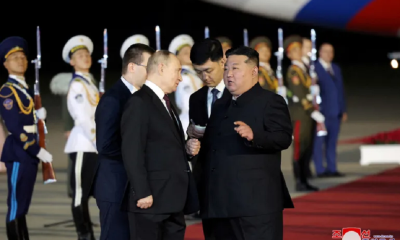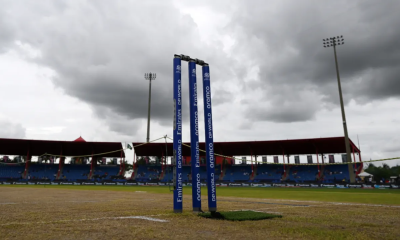Features
In bid to counter China, US ramps up effort to boost military ties in Asia
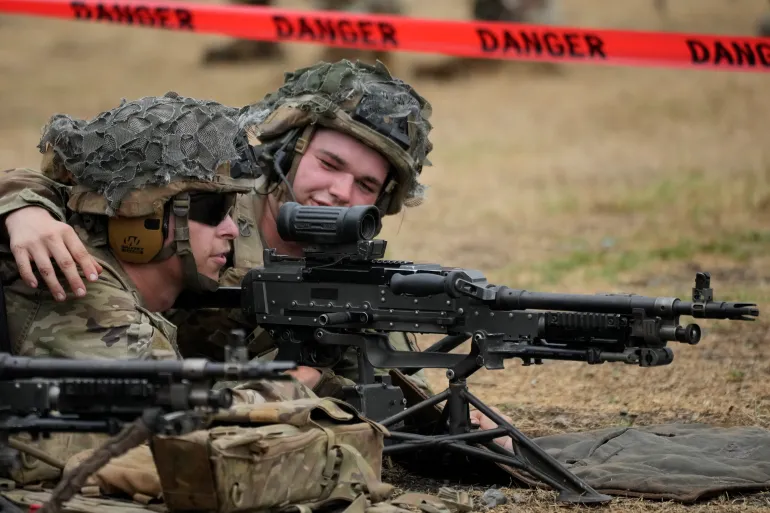
On May 30, the United States accused China of intercepting one of its spy planes in an “unnecessarily aggressive manoeuvre” over the South China Sea. The American RC-135 plane, according to the US military, was conducting routine operations over the sensitive waterway when the Chinese fighter jet flew directly in front of its nose.
A video shared by the US Indo-Pacific Command showed the cockpit of the RC-135 shaking in the wake of turbulence of the Chinese jet.
Days later, on June 5, the US again accused China of carrying out what it said was an ‘unsafe’ manouver near one of its vessels. This time it was around a warship in the Taiwan Strait. The US Indo-Pacific Command again released a video of the incident, showing a Chinese navy vessel cutting sharply across the path of a US destroyer at a distance of some 137 metres (150 yards), forcing the latter to slow down to avoid a collision.
Washington said the near misses showed China’s “growing aggressiveness”, but Beijing said the US was to blame, accusing its rival of deliberately “provoking risk” by sending aircraft and vessels for “close in reconnaissance” near its shores – moves it said posed a serious danger to its national security.
The close calls evoked memories of a deadly incident on April 1, 2001, when a Chinese fighter jet and a US surveillance plane collided in the sky over the South China Sea. The impact caused the Chinese jet to crash and killed the pilot, while the US plane was forced to make an emergency landing in China’s Hainan. Beijing held the 24 American aircrew members for 11 days and only released them when Washington apologised for the incident.
While the two countries were able to de-escalate tensions then, there are worries that a similar mishap today could widen into a bigger conflict due to the deterioration in relations between the rivals.
The US views China as the biggest challenge to the Western-dominated international order, pointing to Beijing’s rapid military buildup – the biggest in peacetime history – as well as its claims over the self-governed island of Taiwan and in the East and South China Seas. The US military’s so-called “freedom of navigation exercises” in the contested waterways near China are part of a push by the administration of President Joe Biden to deepen and expand its diplomatic and military presence in the Asia Pacific.
The campaign – which has accelerated over the past year – stretches from Japan to the Philippines and Australia, and from India to Papua New Guinea and the Solomon Islands. The “once in a generation effort,” as Gregory Poling, director of the Southeast Asia Program at the Center for Strategic and International Studies, puts it, involves the opening of new embassies in the region, deployment of troops and more advanced military assets, as well as obtaining access to sites in key areas facing the South China Sea and the Taiwan Strait.

For its part, China accuses the US of pursuing a policy of “containment, encirclement and suppression”, all aimed at holding back its economic development. And its leaders have pledged to resist.
Chinese President Xi Jinping said the US campaign has “brought unprecedented sever challenges to our country’s development”, and in a speech in March called on his countrymen to “dare to fight”. His former Defence Minister Li Shangfu, during an address at the Shangri-La Dialogue in Singapore, condemned what he called Washington’s “Cold War mentality”, and said Beijing would not be intimidated and would “resolutely safeguard national sovereignty and territorial integrity, regardless of any cost”.
Analysts say tensions will only heighten further as competition between China and the US – a contest about who gets to set the rules on the global stage – intensifies. While the superpower rivalry could bring benefits to countries in the Asia Pacific in the short term – particularly in the form of infrastructure loans and foreign direct investments – these nations could, in the future, find having to navigate between China and the US more challenging.
“This is a competition over what the rules-based order looks like, at least in Asia,” Poling told Al Jazeera. “It’s about whether or not the existing global rules continue to apply to Asia or whether China gets to carve out a huge area of exemption in which its preferred rules predominate.
“Clearly, the next couple of decades at least are going to be characterised by this growing competition. Unless China changes its strategy on this … then we’re going to see competition continue to heighten and tensions continue to heighten not just between the US and China, but also between China and most of its neighbours.”
China’s rise
Japan’s defeat in World War II ushered in an age of US dominance in Asia. But in recent decades, China’s growing military and economic might has brought an end to that uncontested primacy.
Under Xi, who took office in 2012 championing what he calls the “Chinese dream of national rejuvenation”, a vision to restore China’s great-power status, Beijing has invested heavily in modernising its military. According to the International Institute for Strategic Studies, a London-based think tank, China has more than doubled its military spending over the past decade, with expenditure reaching $219bn in 2022 although this is still less than a third of US spending during the same year.
China has also embarked on a naval shipbuilding programme that has put more vessels to sea between 2014 and 2018 than the total number of ships in the German, Indian, Spanish and British navies combined. The People’s Liberation Army (PLA) has since also commissioned guided missile cruisers as well as nuclear-powered ballistic missile submarines. In June 2022, it launched its third aircraft carrier, the Fujian. The PLA’s rocket force has also modernised its capabilities, including with the development of hypersonic missiles and anti-ship ballistic missiles. According to the US military, the PLA also plans to accelerate the expansion of its nuclear arsenal to as many as 700 nuclear warheads by 2027 and at least 1,000 by 2030.
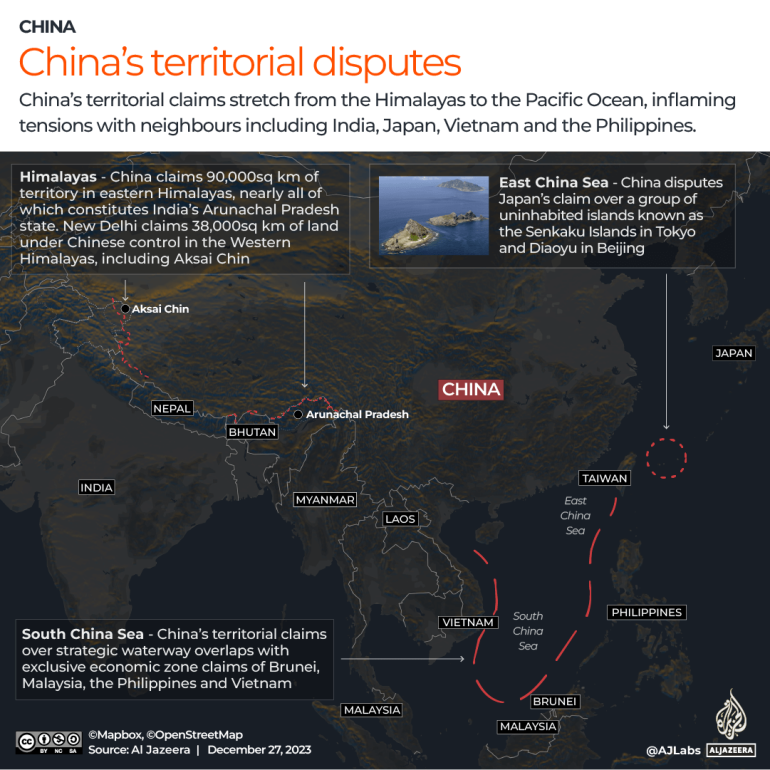
Along with the military build-up, China has also become increasingly assertive in enforcing its territorial claims in crucial waterways off its coast.
In the East China Sea, Beijing lays claim to a group of Japanese-administered islands known as Diaoyu in China and Senkaku in Japan and has increased naval and aerial patrols in the area, drawing protest from Tokyo.
China also lays claim to the entire South China Sea, via its nine-dash line, much to the ire of neighbouring Philippines, Vietnam, Taiwan, Brunei and Malaysia. To shore up those claims, China has built artificial islands in disputed waters, including in the Spratly Islands which it seized from the Philippines in 1996, and expanded its presence in the Paracel Islands which it seized from Vietnam in 1976. China now operates four large outposts with 10,000-foot runways on Woody Island, Fiery Cross Reef, Mischief Reef and Subi Reef. It has also deployed substantial military assets to the islands, including anti-ship missiles, and hangars capable of housing military transport, patrol and combat aircraft.
At the same time, China has faced off with India over their disputed border in the Himalayas. Tensions in the region boiled over in June 2020, when Chinese and Indian troops fought each other with sticks and clubs. At least 20 Indian and four Chinese soldiers died.
Xi has also stepped up rhetoric around Taiwan.
During the Chinese Communist Party’s Congress in September, Xi called unification with the democratically-governed island a “historic mission” and an “unshakable commitment”. The PLA has meanwhile normalised incursions into Taiwan’s Air Defence Identification Zone, the airspace in which Taiwan attempts to identify and control all aircraft.
On the economic front, too, China has grown increasingly powerful.
It is the most important trading partner for more than 120 countries in the world and has sought to expand its economic influence through the ambitious Belt and Road Initiative (BRI). Under the project, sometimes known as the New Silk Road, China has financed physical infrastructure, such as ports, bridges and railways across Asia, Africa and Europe and funded hundreds of special economic zones, or industrial areas designed to create jobs. To date, some 147 countries have signed on to BRI projects or indicated an interest in doing so. In total, China has already disbursed an estimated $1 trillion on such efforts and may spend as much as $8 trillion over the life of the project.
Arc of alliances
The US has sounded the alarm over China’s growing clout.
Biden has called Xi a ‘dictator’, while his administration has accused Beijing of leveraging its commercial, military and technological might to “pursue a sphere of influence in the Indo-Pacific” and “become the world’s most influential power”.
Biden’s Secretary of State Antony Blinken, unveiling the US’s China strategy last year, described the Asian power as “the only country with both the intent to reshape the international order and, increasingly, the economic, diplomatic, military and technological power to do it”.
A key pillar in the US’s campaign to counter China has been its efforts to deepen and expand its military and diplomatic ties with countries in the Indo-Pacific. The campaign – which includes boosting relations with allies such as Australia, Japan and South Korea, and non-allies such as India and Vietnam – has arguably resulted in the most robust US diplomatic and military posture in the Asia Pacific in recent decades.
In Australia, the US, along with the United Kingdom, has announced a historic security partnership to equip Canberra with up to five nuclear-powered attack submarines by the early 2030s. These vessels, which are equipped with long-range missiles, are much harder to detect and can stay underwater far longer than conventional submarines, “making them one of the most effective ways to complicate Chinese military planning and give Beijing a reason to take pause before using force”, according to the Carnegie Endowment for International Peace. Australia and the US have also announced plans to increase the rotational presence of US air, land and sea forces on the island continent, and build airfields to operate nuclear-capable B52 bombers from northern Australia.
In Japan, the US has announced plans to overhaul its troop presence on the Okinawa Islands, including equipping its maritime units there with long-range fire abilities that can hit ships – something that would be key in the event of a Chinese invasion of Taiwan.
In South Korea, which has grown increasingly anxious about neighbouring North Korea’s accelerating nuclear and missile programme, the US has announced new security assurances including the deployment of a nuclear-armed submarine to the Korean peninsula for the first time in four decades. More significantly, the US has announced a new trilateral security partnership with Seoul and Tokyo, a historic achievement given the long history of mutual acrimony between the two countries. At a summit in Camp David in the US in August, the three nations condemned China’s “dangerous and aggressive behaviours” in the South China Sea and pledged to deepen military and economic cooperation to tackle regional challenges.
In the Philippines, another US ally, the government of President Ferdinand Marcos Jr – incensed by Chinese harassment of its vessels in the South China Sea – has granted the Pentagon access to four more sites in the country. This brings to nine the number of locations that US forces have access to in the country – albeit on a rotational basis. Three of the four new sites are in the provinces of Cagayan and Isabela in northern Philippines, facing Taiwan, and the other in eastern Palawan, near the disputed Spratly Islands in the South China Sea. The Philippines and the US have also stepped up the scope and scale of their military exercises, and Washington has reinforced its commitment to defend Manila from an attack at sea. The navies of the two countries are eyeing joint naval patrols in the South China Sea, while the US has also increased freedom of navigation exercises in the waterway.
Vietnam, too, has upgraded its ties with the US. Alarmed by China’s actions in the South China Sea, Hanoi in September elevated the US’s diplomatic status to that of a comprehensive strategic partner – on par with that of China and Russia. The move came during a historic visit to the Vietnamese capital by Biden, and experts say it is indicative of the depth of its concern over its territorial dispute with China in the South China Sea.
On Taiwan, Biden has said on several occasions that the US would come to the island’s aid if there was a Chinese attack. While the White House has since walked back those statements, the Biden administration has continued arms sales to Taiwan, approving more than $3bn in weapons transfers and also allowing US officials to meet more freely with Taiwanese counterparts.
In the Pacific Islands, too, the US has expanded its military and diplomatic footprint.
In May, it signed a security deal with Papua New Guinea that gives it “unimpeded access” to several key airports and seaports in the Pacific nation and re-opened an embassy in the Solomon Islands after a 30-year absence. It has also opened an embassy in Tonga and is in talks with Kiribati and Vanuatu to establish a diplomatic presence there. Biden has also hosted historic summits for Pacific Island leaders in Washington, DC, pledging $810m in new aid for the Pacific Islands over the next decade, including to tackle the existential threat of climate change.
Non-aligned India, too, has stepped up cooperation with the US.
The two countries, along with Australia and Japan have revived an informal alliance known as the Quadrilateral Security Dialogue, or Quad, in a bid to counter China and deliver public goods to countries in the Global South. Quad pledges include a key initiative to help countries protect maritime resources from predatory illegal fishing and promises to invest more than $50bn in developing infrastructure in the Indo-Pacific.
‘Desperation’
Analysts say the US campaign has stirred anger and concern in Beijing.
“This latest phase really just shows an increase in desperation on the part of the US because taking military measures usually is a last resort. Because it’s risky and it’s expensive. It’s also very dangerous. A country that has to resort to these measures, I think, clearly feels it is running out of options and is increasingly desperate to protect its rapidly eroding position in the world,” said Andy Mok, senior research fellow at the Center for China and Globalization in Beijing.
“We only need to look at a map of US military assets to see who’s the aggressor. It’s not that China has numerous military bases surrounding the United States. It’s exactly the opposite. So I think any reasonable observer would question this assertion whether China is really engaging in any sort of military provocations here.”
Mok said China is responding to the US’s efforts by continuing its military modernisation as well as strengthening its own ties.
The military modernisation efforts “include everything from the development of hypersonic missiles to a much stronger navy that is effective not just close to China’s shores, which would include Taiwan, of course, but much broader,” he said. “It includes cyber, includes space from the military perspective. So, becoming a much more comprehensive military force able to respond to threats a number of different ways.”
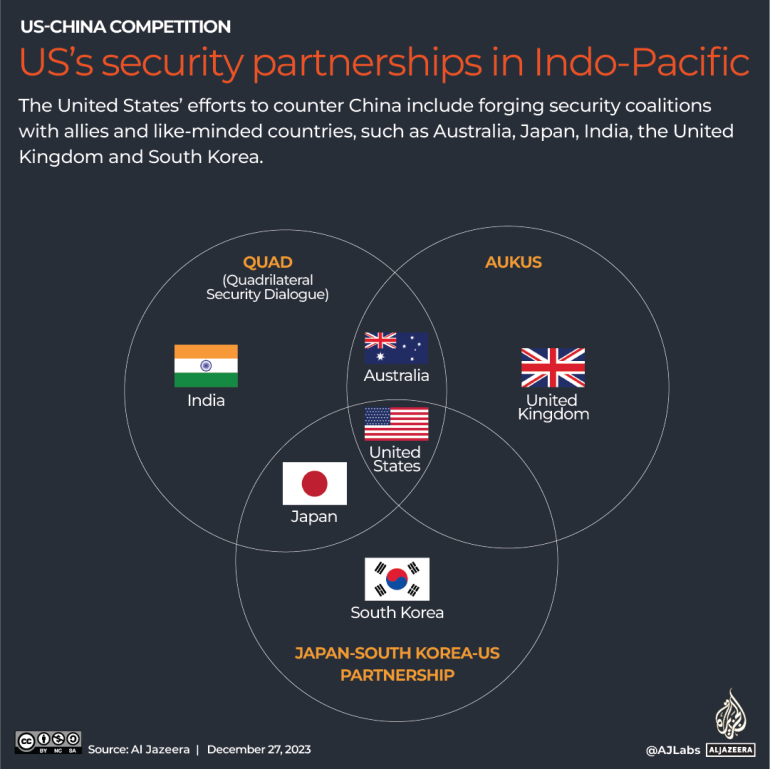
On the diplomatic front, Mok said China will look to strengthen multilateral initiatives such as the Regional Comprehensive Economic Partnership, the world’s largest free trade agreement that brings together 15 countries, the BRICs group that includes Brazil, Russia and India, and the Shanghai Cooperation Organization (SCO), a nine-member Eurasian group that counts Pakistan and Iran among its members.
“These are all attempts to create a more humane and just global order, where these types of issues are, again, not decided by one country and not decided through coercion, whether that’s primarily military coercion or other forms of coercion, including economic sanctions,” he added.
Heightened tensions
For countries in the Asia Pacific, especially in Southeast Asia, the increased US-China competition has brought some economic benefits. To compete with China’s BRI, the US has pledged to step up investment in infrastructure, though much of this investment has yet to bear fruit, while the trade war between the superpowers has resulted in some Southeast Asian countries marketing themselves as alternative production destinations.
“In Southeast Asia, I think the emphasis is on autonomy. And to the extent that they can invite more actors in to have a stake – whether this is the United States, whether this is Korea, Japan, the EU or Australia – that is somewhat more preferred because it dilutes the presence of any single actor,” said Ja-Ian Chong, associate professor at the National University of Singapore.
“With the diversification of investment from the United States, South Korea, Japan, Taiwan, Australia, some Southeast Asian states will be big beneficiaries. So Vietnam, Thailand, Indonesia, and to some degree, the Philippines and Malaysia have seen investment that might otherwise go to China go to them.”
China, Chong said, sees the robustness of US presence in the region as a bit of a challenge.
“The question is, how they will respond? It is possible that they may respond with more caution, which could be stabilising, but there’s also a possibility that they could react even more strongly. But that’s not easy to predict at this point in time.”
So far, it appears that Beijing is seeking to contest the US’s presence.
That is evident not just in the confrontations between US and Chinese vessels and aircraft over the South China Sea and the Taiwan Strait, but also in Beijing’s standoffs with Philippine military boats in the South China Sea. These include incidents in August and earlier this month when the Chinese Coast Guard used water cannon to prevent the Philippine military from resupplying its troops living on a grounded warship on the disputed Second Thomas Shoal.
On Taiwan, too, China’s navy this year launched its largest-ever exercises in the Pacific Ocean, deploying an aircraft carrier and dozens of naval ships and warplanes, in a move analysts said was probably practice for enforcing a blockade around the island. Beijing said the purpose of the drills was to “resolutely combat the arrogance of Taiwan independence separatist forces and their actions to seek independence”.
Chong said the tensions were likely to pose new challenges to countries in the region.
“I expect the contestation to become more intense. Meaning to say that trying to navigate between the two major powers will become more challenging, not impossible, but certainly more challenging. To expect that you can act in ways that get benefits from both sides may become more difficult. It may be the case that working with one more will invite pressure from the other,” said Chong. “That is likely to be a challenge facing Southeast Asia unless they are more able to set up their own direction.”
(Aljazeera)
Features
Are we witnessing end of globalisation? What’s at stake for Sri Lanka?

Globalisation can be understood as relations between countries, and it fosters a greater relationship between countries that involve the movement of goods, services, information, technology, money, and human beings between countries. These relationships transcend economic, cultural, political, and social contexts.
Globalisation in the modern world today is a significant shift from the past. Globalisation in the modern world today is a state in which the world becomes interconnected and interdependent. This change occurs due to better technology, transport, communication, and foreign trade.
Trade routes have joined areas for centuries. The Silk Road and colonial sea trade routes are the best examples. But today, nobody can match the speed and scope of globalization.
Globalisation began to modernise after World War II. During this time, countries came to understand that they had to work together. They wanted to have economic cooperation and peace so that they would not fight any more. These significant institutions united countries for political and economic purposes and advantages. They allow free movement of products, services, and capital between countries. It encourages cooperation all over the world.
The second half of the 20th century saw fabulous technological advances. These advances sped up globalisation. The internet changed everything. It changed the way people communicate, share information, and do business. Traveling became faster and more efficient. Products and humans travel from one continent to another in record time. Companies can now do business globally. They outsource jobs, get access to global markets, and use global supply chains. This was the dawn of multinational firms and a global economy.
Flow of information is one of the characteristic features of the current age of globalisation. The internet allows news, ideas, and culture to be shared in real-time. Societies are experiencing unprecedented cultural interconnectedness. This has led to controversy over cultural sameness and dissimilation of local cultures. For example, the same is observed within countries too. In countries such as Sri Lanka the language differences between districts have become a non-issue, and the western province’s language has paved the way for others to emulate. Globalisation has allowed millions of individuals to lift themselves out of poverty, especially in Asia and Latin America. It does this by creating new employment opportunities and expanding markets. It has also increased economic inequalities, though. Wealth flows to those who possess technology and capital. Poor workers and communities are unable to compete regionally or internationally. Some countries have seen political backlash. In these countries, some people feel left behind by the benefits of globalisation.
Modern globalisation has a lot to do with environmental concerns. More production, transportation, and consumption have destroyed the planet. These are pollution, deforestation, and climate change. Global issues need global solutions. That is why international cooperation is essential in solving environmental problems. The Paris Climate Agreement is one such international effort to cooperate. There are constant debates regarding justice and responsibility between poor and rich countries.
Modern-day globalisation deeply influences our daily lives in many ways. It has opened up possibilities for economic growth, innovation, and cultural exchange. However, it also carries with it dire consequences like inequality, environmental destruction, and displacement of culture. The future of globalisation will be determined by the way we handle its impact. We have to see to it that its benefits are distributed evenly across all societies.
Tariffs are globalising-era import taxes. Governments levy them to protect domestic firms from foreign competition. But employed ruthlessly and as retaliation like today, and they can trigger trade wars. Such battles, especially between big economies such as the U.S. and China, can skew trade. They can destabilise markets and challenge the new era of globalisation. Tariff wars will slow or shift globalisation but won’t bury it.
Globalisation is not just a product of dismantling trade barriers. It is the product of enormous forces like technology, communications, and economic integration in markets across the globe. Tariffs can limit trade between countries or markets. They cannot undo the fact that most economies in the world today are interdependent. Firms, consumers, and governments depend on coordination across borders. They collaborate on energy, finance, manufacturing, and information technologies.
However, the effects of tariff wars should not be downplayed. Excessive tariffs among dominant nations compromise international supply chains. This also raises the cost for consumers and creates uncertainty for investors. The 2018 U.S.–China trade war created billions of dollars’ worth of tariffs. It also lowered the two countries’ trade. Industries such as agriculture, electronics, and automotive manufacturing lost money. These wars can harm international trade confidence. They also discourage higher economic integration.
There are some nations that are facing challenges. They are, therefore, diversifying trade blocs. Others are creating domestic industries. Some are also shifting to regional economic blocks. This may result in more fragmented globalisation. Global supply chains can become short and local. The COVID-19 pandemic and tariff tensions forced countries to re-examine the use of foreign suppliers. They began to stress self-sufficiency in vital sectors. These are medicine, technology, and food production.
Despite these trends, globalisation is not robust. The global economy can withstand crises. It does so due to innovation, new trade relations, and digitalisation. E-commerce, teleworking, and online communication link people and businesses across the globe. Sometimes these links are even stronger than before. Countries need to come together in order to combat challenges like climate change, pandemics, and cybersecurity. This is happening even as economic tensions rise.
Tariff wars can disrupt trade and create tensions.
However, they will not be likely to end globalisation, but instead, they reshape it. They might change its structure, create new partnerships, and help countries find a balance between openness and security. The globalization forces are strong and complex. They can be slowed down or reorganized, but not readily undone. The future of globalisation will depend on how countries strike their economic interests. They must also recognise their interdependence on each other in our globalised world. The world economy has a tendency to change during crises.
It does this through innovating, policy reform, building strong institutions, and changing economic behavior. But they also stimulate innovative and pragmatic responses by governments, companies, and citizens. The world economy has shown that it can heal, change, and change after crises like financial downturns, pandemics, and geo-political conflicts. One of the more notable examples of economic adjustment occurred in the 2008 global financial crisis. The crisis started when the housing market in the U.S. collapsed. The big banks collapsed, and then the effects spilled over to the world. This led to recessions, very high unemployment levels, and a drop in consumer confidence. In response, central banks like the U.S. Federal Reserve and the European Central Bank acted very quickly. They cut interest rates to near zero. They also started large-scale quantitative easing. Governments spent stimulus money in their economies. They assisted in bailing out banks and introduced tax-tight financial regulations. These actions stabilised markets and ultimately restored economic growth. The crisis also led to new financial watchdog mechanisms. One example is the Financial Stability Board, which has the objective of avoiding such collapses in the future. The COVID-19 pandemic created a unique crisis.
It reached health systems and economies globally. In 2020, the world suddenly stopped. Lockdowns and supply chain disruptions followed. This led to a sharp fall in GDP in almost all countries. Sri Lanka experienced it acutely. However, the world economy has adapted at a breathtaking speed. Remote work and online shopping flourished, driven by digital technology. Firms transitioned to new formats like contactless offerings, delivery platforms, and remote platforms. Governments rolled out massive stimulus packages to businesses and employees. Central banks infused liquidity to support financial systems. International cooperation on vaccine development and distribution also helped accelerate economic recovery. By 2021 and 2022, various economies were quicker to recover than expected, though unevenly by region. Another outstanding one is the manner in which economies adapted to geostrategic struggles:
The war of 2022 between Ukraine and Russia ravaged across world markets of food and energy, with special impact on Europe and the Global South.
European nations moved swiftly to abandon Russian natural gas. European nations also looked around for other sources of energy and increased usage of renewables. While shock caused inflation as well as supply shortages to a peak first, markets began to shift ultimately. And world grain markets looked elsewhere and established new channels of commerce. Such changes show the ways that economies can change under stress, even if ancient structures are upended. Climate change is demanding long-term change in the world economy.
The climate crisis isn’t a sudden crisis, like war or pandemic. But it’s pushing nations and businesses to make big changes. Green technologies are on the rise. Electric vehicles, solar and wind power, and carbon capture are the best examples. These technologies are indicative of how economies address environment crises. Financial institutions and banks are now embracing sustainable investing guidelines. Countries are uniting in a low-carbon future under the terms of the Paris Climate Accord. Technology is leading economic resilience.
The digital economy is going stratospheric—AI, cloud computing, and e-commerce are the jetpack! These technologies enable companies to be agile and resilient. Consider the pandemic and the financial crisis, for instance. Technology businesses did not just survive; they flew like eagles. They gave us remote work tools, digital payments, and virtual conversations, allowing us to stay connected when it was most important. These innovations have irreversibly shifted the terrain of worldwide business and work. The global economy’s history is marked by crises and its capacity to adapt and transform in response. The global economy proves strong during financial crises, pandemics, conflicts, and climate issues. Resilience shines through innovation, teamwork, and strategic adjustments. Though challenges linger and vulnerabilities remain, we’re not without hope.
Learning from crises helps us fortify and adapt our systems. This adaptability signals a promising evolution for the global economy amid future uncertainties.
The current trade war, especially between the United States and China, is reshaping globalization. It may lead to a new form of it. These tensions do not terminate globalization. Instead, they push it to evolve into a more complex and regional form. The new model includes economic factors. It also includes political, technological, and security factors. This leads to a world that remains interconnected but in more cautious, selective, and fragmented ways.
Trade wars tend to begin when countries want to protect their industries.
They might want to lower trade deficits. They also respond to unfairness, including intellectual property theft or state subsidies. The ongoing trade war between China and the U.S. has seen massive tariffs, export quotas, and increasing geopolitical tensions. This is a sharp departure from the post-Cold War era, which saw more free and open trade. Now, companies and governments prepare for everything. Safety and national interests are their concerns. This change is reflective of a trend that some experts call “de-risking” or “strategic decoupling.” One of the most obvious signs of this new course is the reorganization of global supply chains.
Many global companies want to diversify away from relying on one country. They especially want to decouple from China for manufacturing and raw materials. They diversify production by investing in different regions. It is called “China plus one.” It means relocating operations to locations like Vietnam, India, and Mexico. This relocation takes global supply chains from centralized to more regionalized and redundant networks. These networks prepare for future shocks. Moreover, technology and digital infrastructure have an increasing role in this new globalization.
Trade tensions are an indication of the strategic value of semiconductors, telecommunications, and artificial intelligence. Nations are realizing that technology is a national security issue. Therefore, they have invested in their local capabilities and restricted foreign technologies’ access. The U.S., for example, has put export restrictions on high-end microchips and blocked some Chinese technology companies from accessing its market. China and other nations have increased efforts in developing independent ecosystems for technologies. This has given rise to parallel technology realms. This could result in a “bifurcated” global economy with different standards and systems. The current trade war is also strengthening the advent of regional trading blocs.
Global trade agencies like the World Trade Organization are getting weakened. This is owing to the fact that the world’s major nations are competing with one another. Hence, the nations are currently opting for regional agreements to develop economic cooperation. Discuss the Comprehensive and Progressive Agreement for Trans-Pacific Partnership (CPTPP) and the Regional Comprehensive Economic Partnership (RCEP) in Asia. And let’s not forget the United States–Mexico–Canada Agreement (USMCA). Collectively, these agreements represent a new era of globalization. It’s no longer a free-for-all; rather, it’s a strategic web spun with trusted partners and regional ambitions resulting in ‘islands’ or ‘regions’ of globalization. The new model of globalization creates greater independence and security for some but presents issues.
The countries that previously prospered from the exportation of goods and involvement in the global market may face greater challenges. As protectionism rises and competition becomes greater, customers may pay more. Economic inefficiencies are a likely reason. Additionally, the disintegration of international institutions may stop countries from agreeing on important issues. Problems like global warming, pandemics, and economic downturns can become harder to resolve. The current trade war will not end globalization, but it is reshaping it. We see a new type of globalization that is fragmented, regional, and strategic in character. Countries are still interdependent, but such economic dependency is underpinned by trust, security, and competition. Globalization is changing, so we must balance these changes with the imperatives of cooperation in our globalized world.
New types of globalization include regional trade blocs, reshaping supply chains, tech decoupling, and growing geopolitical tensions.
For Sri Lanka, the changes have far-reaching consequences.
Being a small nation strategically located, Sri Lanka relies on trade, tourism, and foreign investment. Globalization is, however, more fragmented and politicized and security-oriented. This offers opportunities and challenges for Sri Lanka. To survive, the country must reform its economic policies. It must diversify relationships and maneuver the rival interests of global powers with caution.
One of the most immediate effects of the new globalization is realigning global supply chains.
Multinationals want to wean themselves from China. They want to shift production elsewhere. Sri Lanka can be a new hub for light manufacturing, logistics, and services. Being located on key shipping routes in the Indian Ocean means that it is a vital node in global ocean trade. Sri Lanka can lure more foreign investment by improving its infrastructure, bolstering digital strength, and upgrading the regulations. This would help firms to open up business. This would create employment as well as improve export-led growth. But the shift towards regionalism in global trade also poses danger.
The rest of the countries outside these alignments might be left out as major economies create closed trading blocs. Examples include the Regional Comprehensive Economic Partnership (RCEP) and bilateral agreements like the Indo-Pacific Economic Framework. Sri Lanka is not part of most of the world’s biggest trade blocs, limiting its access to large markets and preferential trade conditions. Exclusion could make exports less competitive. It could also reduce the nation’s appeal as an international production base. To fulfill this, Sri Lanka must pursue trade agreements with regional powers like India and ASEAN nations in order to keep up with shifting trade networks. One key feature of the new era of globalization is a focus on ‘technological sovereignty’.
This includes the rise of alternative digital ecosystems, especially between China and the US. Sri Lanka must manage the tech divide wisely. Countries are closing doors to other people’s technologies and creating their own networks. Cyber security, digital infrastructure, and data governance require investments. Sri Lanka also needs to balance embracing new technology while preserving its digital sovereignty. Dependence on technology from a single country could yield dangers, as digital tools will be the main movers in the realms of governance, finance, and communication. Geopolitical competition, especially in the Indo-Pacific, also affects Sri Lanka’s economic and strategic location.
The island’s location has drawn China and India and Western nations. China’s involvement in Sri Lankan infrastructure projects, such as the Hambantota Port and the Colombo Port City, has yielded economic advantage as well as concerns regarding debt dependence and strategic control. Meanwhile, India and its allies have expressed interest in balancing Chinese power in the region. This is a sensitive balance that Sri Lanka has to exercise strategic diplomacy to reap foreign investment without being entangled in great power rivalry or compromising sovereignty. In addition, economic resilience in the face of global shocks—such as the COVID-19 pandemic, energy shocks, and food crises—has emerged as a top priority in the new era of globalization.
The recent economic slump in Sri Lanka, marked by a sovereign default, foreign exchange crises, and inflation, underscored the country’s vulnerability to global shocks. These events underscore the need for greater economic diversification, sound fiscal management, and long-term development. Sri Lanka must build stronger domestic industries, shift to clean energies, and transform regional supply systems that are less vulnerable to shocks from the outside. Generally speaking, therefore, the new patterns of globalization present Sri Lanka with a risk-laden world of possibility too.
While transforming global patterns of trade and investments creates new doors to economic growth, it steers the country towards more aggressive competition, geopolitical tensions, and internal vulnerabilities. To thrive in this fast-evolving world, Sri Lanka must adopt an assertive strategy of regional integration, technological resilience, strategic diplomacy, and inclusive economic reform. On the way, it can transform foreign uncertainty into a platform for sustainable and sovereign development.
by Professor Amarasiri de Silva
Features
Fever in children

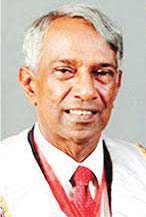 by Dr B.J.C.Perera
by Dr B.J.C.Perera
MBBS(Cey), DCH(Cey),
DCH(Eng), MD(Paed), MRCP(UK), FRCP(Edin), FRCP(Lond), FRCPCH(UK),
FSLCPaed, FCCP, Hony. FRCPCH(UK), Hony. FCGP(SL)
Specialist Consultant Paediatrician and Honorary Senior Fellow, Postgraduate Institute of Medicine, University of Colombo, Sri Lanka.
Joint Editor, Sri Lanka Journal of Child Health Section Editor, Ceylon Medical Journal
Fever is a common symptom of a variety of diseases in children. At the outset, it is very important to clearly understand that it is only a symptom and not a disease in its own right. When the body temperature is elevated above the normal level of around 98.6 degrees Fahrenheit (F) or 37 degrees Celsius (C), the condition is referred to as fever. It is a significant accompanying symptom of a plethora of childhood diseases. All children would get a fever at some time or another in their lives, and in the vast majority of cases, this is due to rather mild illnesses, and they are completely back to normal within a few days. Some may have a rather low-grade fever, while others may have quite a high fever. However, in certain situations, fever may be an important indication of an underlying serious problem. The significance depends entirely on the circumstances under which this occurrence is seen.
Irrespective of the actual underlying reason for the fever, the basic mechanism of causation of fever is the temporary resetting of the temperature-regulating thermostat of the brain to a higher level. The consequences are that the heat generated within the body is not effectively dissipated. It is merely a body response to a harmful agent and is a very important defence mechanism. Turning up the core temperature is the body’s way of fighting the germs that cause infections and making the body a less comfortable place for them. However, less commonly, it is also a manifestation of other inflammatory disorders in children. The significance of fever in such situations is a little bit different to that which is seen as a response to an infection.
The part of the human brain that controls body temperature is not fully developed in young children. This means that a child’s temperature may rise and fall very quickly and the child is also more sensitive to the temperature of his or her surroundings. Although parents often worry and get terribly scared with the child developing fever, it does not cause any harm by itself. It is a good thing in the sense that it is often the body’s way of fighting off infection.
It is quite important to note that the actual level of the temperature is not always a good guide to how ill the child is. A simple cold or other viral infection can sometimes cause a high fever in the region of 102 to 104 degrees Fahrenheit or 39 to 40 degrees Celsius. However, this does not always indicate a serious problem. It is also true to say that some more sinister infections could sometimes cause a much lower rise in the body temperature. Because fevers may rise and fall, a child with a fever might experience chills and shivering as the body tries to generate additional heat as the body temperature begins to rise. This may be followed by sweating as the body releases extra heat when the temperature starts to drop. Children with fever often breathe faster than usual and generally have a higher heart rate. However, fever accompanied by obvious difficulties in breathing, especially if the breathing problems persist even at times the temperature is normal is of significance and requires urgent medical evaluation of the situation. Generally, in the case of children, the way they act is far more important than the reading on the thermometer, and most of the time, the exact level of a child’s temperature is not particularly important, unless it is persistently very high.
Although many fevers need just simple remedies, under certain conditions the symptom of fever needs rather urgent medical attention. This is the case in babies younger than three months. Same is true even in a bigger child if the fever is accompanied by uncontrollable crying or pain in the neck with a severe headache. Marked coughing and or difficulty in breathing coupled with fever needs to be medically sorted out. Fever combined with pain and difficulty in passing urine, significant tummy pains or marked vomiting and diarrhoea too would need medical attention. Reddish rashes and bluish spots on the skin with fever also need to be seen by a doctor. The illness is probably not serious if a child with a history of fever is still interested in playing, is eating and drinking well, is alert and smiling, has a normal skin colour and looks well when his or her temperature comes down. However, even with rather low levels of fever, under certain conditions, medical attention should be sought. In situations such as when the child seems to be too ill to eat and drink, has persistent vomiting or diarrhoea, has signs of dehydration, has specific complaints like a sore throat or an earache or when fever is complicated by some other chronic illness, it is prudent for him or her to be seen by a qualified doctor.
One could take several steps to bring down a fever. It is very useful to remove most of the clothes and keep under a fan to facilitate heat loss from the body. If there is no fan available, one could try fanning with a newspaper. A very effective way of bringing down a temperature is to sponge the body with a towel soaked in water. The water must be at room temperature or a bit higher. One should not use ice or iced water on the body. Ice will lead to contraction of the blood vessels of the skin and the purpose would be lost as more heat will be conserved within the body. There is no evidence that ice on the head helps to bring down the fever or to prevent a convulsion. If a medicine is to be used, paracetamol is probably as good as any other drug, but the correct dosage according to the instructions on the container should be used for optimal benefit. The best way of calculating the appropriate dose is by using the body weight. It is very important to stress that aspirin and aspirin-containing medications should not be used in children, merely to bring down a fever.
A child with fever loses a considerable amount of fluid from the body, particularly due to sweating. It is beneficial to ensure that the child drinks plenty of fluids. A good index of the adequacy of fluid intake is the passing of normal amounts of urine. A reduced solid food intake would not matter that much just for a couple of days of fever, but in prolonged fevers adequate nutrition too becomes quite important. A child with a high temperature also needs rest and sleep. They do not have to be in bed all day if they feel like playing, but they must have the opportunity to lie down. Sick children are often tired and bad-tempered. They sleep a lot, and when they are awake, they want their parents around all the time. Perhaps it is quite useful to spoil them a little bit when they are ill and to read to them, play with them or just spend time with them. It is best to keep a child with a fever home and not send him or her to school or child care. Most doctors would agree that in simple fevers, it is quite satisfactory for the child to return to school or child care when the temperature has been normal for over 24 hours.
Trying to get the temperature down would make the child more comfortable. However, it is not essential to get it down to normal and to keep it there scrupulously. Parents often worry that either the fever simply refuses to abate or springs up again after a couple of hours. It must be realised that certain fevers have to run their course and will not come down to normal in a hurry, despite whatever measures that are undertaken. This is particularly true of viral fevers. Some parents are terribly worried at the slightest elevation of the temperature and go running to doctors looking for a “magic cure” for the fever. Many fevers do not need urgent medical attention and one could watch it for a few days and see how it progresses. Yet for all that, if there are some worrying signs then it is advisable to seek advice from a qualified doctor.
It is a familiar occurrence that many people believe that a high fever is quite dangerous. Fever by itself has no major long-lasting effects. If one appreciates that high fever is just a symptom and that it is only a reaction of the body to something untoward going on, then it is easy to consider it to be just like any other symptom of a disease. Some are also under the misconception that a high fever could cause a convulsion. This is not always the case, and a convulsion would occur only in those children who have the constitutional tendency to get them. Convulsions are not always related to high fever, and in those who are susceptible, even moderate and sometimes mild fever could trigger a convulsion. High fever does not lead to lasting brain damage in its own right either. Fever is sometimes an indication of a significant infection, but in those circumstances, the primary disease itself is the real problem. In situations where medical help is desirable, what is most important is the way a fever is sorted out and some kind of a diagnosis being made as to the real cause of the fever. The crucial component of the treatment of a fever caused by an underlying problem is the treatment of the root cause.
Features
Robbers and Wreckers
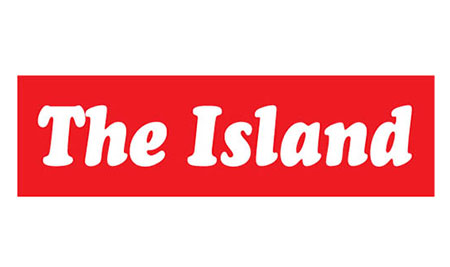
To quarrel with them is a loss of face
To have their friendship is a sad disgrace
Those lines by Bharavi were written after the fourth century A.D. when Sanskrit was already a purely literary language.
We have had the spectacle of a reporter in DC asking Donald Trump whether he regrets his lying all the time every day of his life. And, Trump responded “What did you say?” and one could see that such a possibility had never occurred to him: he was genuinely baffled.
The question here and now is whether such a thought has ever come to Anura Kumara Dissanayake and Harini Amarasuriya, both obedient servants of the US and India. For example, the prathigna given by Amarasuriya as she was sworn in by AKD as Prime Minister in a Cabinet of three. That their doings are in line with the desires of Ranil Wickremesinghe (and maybe the “aspirations” of their buddies) would translate also to the cover up of his bringing in Arjuna Mahendran, the son of a Chairman of the UNP, to trash the Central Bank and execute Ranil’s bond scam.
In the matters of managing our economy and respecting our age-old culture this lot have shown us glimpses of the lunatic self-applause that define Trump’s doings. As phrased by a commentator in the U K Guardian a few days ago Trump’s endeavours “weren’t about Making America Wealthy Again. This was much more primal. Sticking it to all the people who had laughed at him over the years. His bankruptcies. His hair. His orangeness. His stupidity. Sticking it to all those who had taken him to court and won. Now he was the most powerful person in the world. He had the whole world watching as he messed it up. He could do what he liked.”. It’s quite obvious that the last is how AKD, HA, Yapa and the top tier of those most culpable have read their horoscopes: they do not expect to be held accountable
“The U.S.’s new tariff policy reflects a broader shift away from globalisation and towards economic nationalism and national balance sheet economic model approach”. So wrote a self-styled Business Cycle Economist last week. That is the kind of delusion that ‘growth-friendly’ market theory such ‘economists’ are trained to shove down the throats of politicians possessed of just about the bit of wit required to enrich themselves in tandem with the IMF and those entrepreneurs it supports.
At this point we should note also that Trump’s new wave of tariffs was harshest on Cambodia, Myanmar, Thailand, Vietnam and Sri Lanka––all, coincidentally, in addition to their strategic importance for war-mongers, Buddhist countries.
How closely those who call the shots among the power-wielders here follow Trump is seen in their response or lack of one to the earthquake that has devastated Myanmar and Thailand a week ago. The USA has been salivating over the riches of Myanmar for a long time, confident that Aung Suu Kyi would deliver them on a platter. That no doubt was the object of the aragalaya here and seems within reach for India now.
For months now, from 2022 at least, there have been markers that showed who was running the Janatha Vimukthi Peramuna (so calling themselves) and what their agenda was with respect to our country and her people. An early eruption that showed their hand was that aragalaya‘. It was designed to ensure a regime change that would place, let us for convenience say, Adani in charge. It involved, as a first step, getting Gotabhaya out of the presidency. That it was so was also shown two years ago in the London Review of Books by Pankaj Misra in an essay titled “The BIG CON” on Modi’s India. In which Gotabhaya and Adani are mentioned and the above object specified.
Misra’s latest work has been on “The World After Gaza” – a reference not without its applications not only to Modi’s support for Adani in Haifa, but to the ridiculous and altogether culpable gestures of friendship towards the US-Israeli led coalition of criminals shown by Ranil Wickremasinghe and associated Colombians who succeeded him. Haifa is the largest port in that segment of occupied Palestine and the Trump group also has had a stake in it.
I shall pause here with the concluding lines of Bharavi’s quatrain.
One of sterling judgment realizes
What fools are worth and foolish ones despises.
by Gamini Seneviratne
-

 Business6 days ago
Business6 days agoColombo Coffee wins coveted management awards
-

 Features7 days ago
Features7 days agoStarlink in the Global South
-

 Features2 days ago
Features2 days agoRobbers and Wreckers
-

 Features4 days ago
Features4 days agoSri Lanka’s Foreign Policy amid Geopolitical Transformations: 1990-2024 – Part III
-

 Features7 days ago
Features7 days agoModi’s Sri Lanka Sojourn
-

 Midweek Review4 days ago
Midweek Review4 days agoInequality is killing the Middle Class
-

 Features6 days ago
Features6 days agoSri Lanka’s Foreign Policy amid Geopolitical Transformations: 1990-2024 – Part I
-

 Features5 days ago
Features5 days agoA brighter future …


